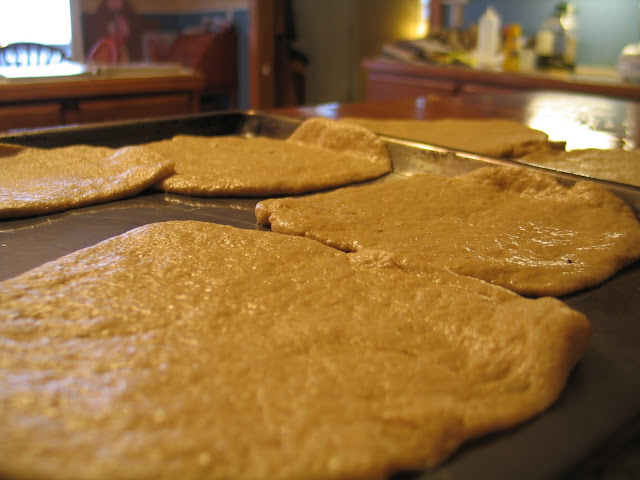I know, I know; this is not a food blog. But I keep eating all these great meals and I feel like sharing them. Seeing pictures is not nearly as good as eating the food. It looks so good, I am getting hungry right now. Someone may be inspired to make it themselves. Yet another post with
Pioneer Woman style pictures.
This is a Mediterranean style lunch - pita bread sandwiches and hummus. We don't claim to be Mediterraneans, or that the food here is 100% authentic, we just like eating pita bread and hummus.
So here we go...
Start with the dough for the pita bread. I think Maggie doubles or triples the recipe from the cookbook. Mix up the ingredients and knead the dough, either by hand or using a fancy Bosch mixer. Let the dough sit awhile. It will start rising. The expansion that follows may get out of hand....
Take the dough out and divide it into balls. Maggie is rolling them into flat circles. Don't roll them too thin, they are not going to rise much more.
Here is the dough in the pan.
While Maggie is doing that, let's get the hummus ready. Start with some chickpeas, either from a can or from dried peas. These were dry peas and have been boiled.
Put them in a food processor with tahini, lemon juice, garlic and extra virgin olive oil. Blend until smooth, then serve in a pretty bowl with parsley on top. Add more oil on top if so desired. As you can see, we like our olive oil.
Mix up some tuna salad. No recipe is given because I figure most folks can do this, and you know how you like it.
Back with the pita bread. It has to cook at 500 degrees, and the quickest way to do that is on a grill. Dad is the grill-master, so he gets to help out here.
The pitas are supposed to puff up and create an air pocket. They never do for us - so we just slice open a pocket. It's all about the taste anyway, who cares how the pocket got there?
Doesn't this look delicious? My stomach is rumbling.....
Now we are ready to eat. Put some tuna in the pocket, and get some hummus quick, before it's all gone.
That hummus is good stuff....Every bit gets licked up, scraped the bowl, cleaned the plates...
Whole Wheat Pita Pockets
1 ¼ c warm water 1 tbl oil
1 tsp salt 2 tsp sugar
2 ¾ c soft whole wheat flour 1/3 c wheat gluten
1 ½ tsp dry yeast
In large bowl, combine water, oil, salt and sugar. Add the gluten and 1 cup of the flour, along with the yeast, and stir to mix. Add remaining flour and knead to make a soft dough. Add additional flour if necessary.
Put dough into a bowl, lightly oil the top and cover. Set in a warm place to rise until almost double (about an hour). Punch down dough and turn onto a lightly floured surface. Using a sharp knife, cut dough into 8 equal pieces. Form each piece into a ball. On a lightly floured surface, roll each ball into a 6-7 inch circle. Do not let it get too thin!
As you roll the rounds, set them aside on a lightly floured countertop and cover loosely with a towel. Let rise for about 30 minutes, until slightly puffy.
Preheat grill to 500 degrees. Grill for 4-5 minutes, until puffy and just slightly browned. Remove immediately and wrap/layer in a damp towel. Continue to grill the other rounds. Makes 8 pita pocket rounds.
Hummus
32 oz chick peas ½ c liquid drained from can of chickpeas
½ c lemon juice ¼ c tahini
1 tsp sea salt 4 cloves garlic, crushed
¼ c olive oil
Drain chickpeas and set aside liquid from can. Combine remaining ingredients in food processor. Add ½ c of liquid from chickpeas. Blend for 3-5 minutes on low until thoroughly mixed and smooth. Place in serving bowl, create a shallow well in the center of the hummus. Add a small amount of olive oil in the well. Garnish with parsley. Serve immediately with fresh, warm pita bread, or cover and refrigerate.





























